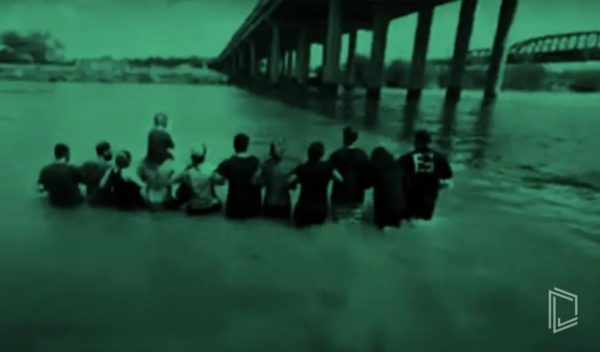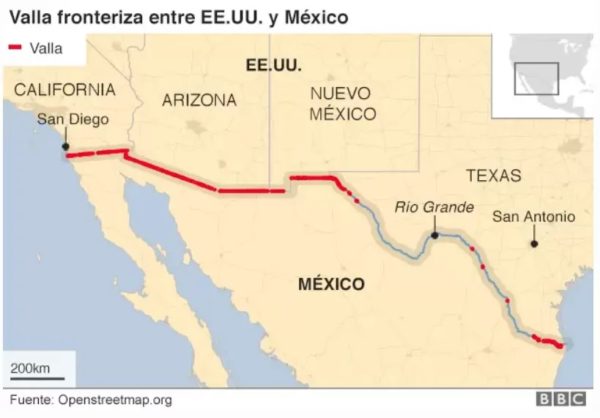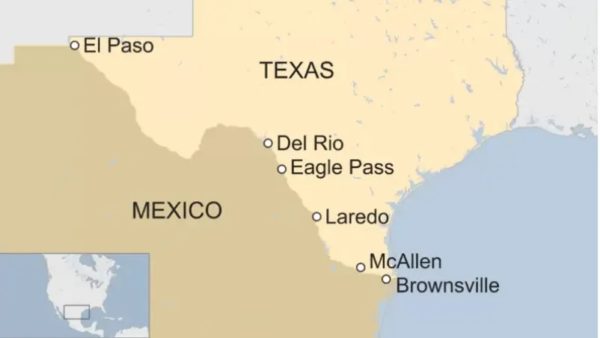Rio Grande: The Last Danger for Cuban Migrants in Mexico

HAVANA TIMES – The shortest route to the US from the center of Mexico is southern Texas. But legal crossing of the border is only possible via border crossing points because the Rio Grande (Rio Bravo in Mexico) flows along a huge portion of the southern border. However, many thousands of migrants, including Cubans, choose to cross the river instead of handing themselves over at border crossing points (which are closed) in an attempt to sidestep Mexican immigration controls and speed up their entry into the US. They expose themselves to many risks in the process.
The river on the US-Mexican border
A long border of 3142 kilometers (km) separates the US from Mexico. Almost 1000 km are a land border, while the remaining 2018 km are a river border.
The land border spans across the states of California, Arizona and New Mexico (in the US) and Baja California Norte, Sonora and a part of Chihuahua (on the Mexican side). A third of this border are protected by a kind of wall or metal fence, especially in urban areas.
The course of the Rio Grande, traces the rest of the border. It springs from the San Juan Mountains (Colorado). It has a total course of approximately 3060 km, until it meets the Atlantic Ocean, in the Gulf of Mexico.
The river flows southeast from its source, crossing Colorado (280km) and New Mexico (760 km) within the US. Then, starting at El Paso and Ciudad Juarez, it draws the border between the two countries going east.

According to information divulged by the Mexican Government, there are 20 border crossings on the land border and 36 bridges over the Rio Grande from El Paso to the Gulf.
A report by “The Washington Post” identified the crossing in Del Rio, in Coahuila State, as the border crossing with Texas where most Cubans handed themselves over to immigration authorities in March 2022.
However, the stretch from the crossing in Del Rio towards Brownsville (passing through Eagle Pass, Laredo and McAllen) is known as the most dangerous point to cross the river and, as a result, isn’t recommended. This is because there are two international dams in this stretch: La Amistad and Falcon.

La Amistad has a storage capacity of 7050 million cubic meters. It is the sixth largest dam in Mexico and is located in Ciudad Acuña, in Coahuila State. Meanwhile, Falcon is located on the Rio Bravo, 120 km downstream from the city of Nuevo Laredo, in Tamaulipas State. Water is transfered between these dams (La Amistad releases a flow of water that reaches Falcon), that moves through the Rio Grande.
While the river is recognized as non-navigable – except for small boats – due to it not being very deep, a dam transfer increases the volume of water by over one meter in depth. Plus, lots of branches or parts of trees or plants are dragged along it, and strong currents are created by releasing the flow.
The State Government’s Civil Protection authorities announce the water transfer in advance, in the local press and official websites. In early March 2022, the most recent transfer was announced and they warned that this would result in the river swelling for the entire month.
Normally, La Amistad releases approximately 80 cubic meters per second (m3/s) of water into the river. Bryan Kemmett, the officer responsible for the Eagle Pass section, explains that river levels, downstream from the dam, rise up to 90 cm above the traditional flow, when the dam is open to irrigate crops and supply electricity.
According to information provided by the BBC – in rainy season (between April and October), the dam releases part of its flow to reduce the water level and creates sudden swelling, which makes the river more dangerous near the Eagle Pass and Laredo crossings. Since 2014, the area near McAllen has resulted in the most fatalities recorded on the entire border.
Cubans’ experiences along this stretch of the river confirm official records
In June 2020, the family of 23-year-old Cuban Jorge Tomas Reyes confirmed the discovery of his lifeless body, four days after he tried to swim across the Rio Grande, in the area that borders Reynosa, along with two friends.
In early March this year, the story of 33-year-old Cuban Guillermo Alan Matos, traveling from Uruguay, went viral on social media, as he lost his 25-year-old wife and his 4-year-old son, who were dragged to their deaths by the river current, in Ciudad Acuña, Coahuila, while trying to cross it. Only Guillermo Alan was able to get back to the Mexican shore with life.
At the end of that same month, the story of a girl and her mother, both Cubans, also made the headlines, when they managed to reach the other shore safely, thanks to the help they received from their fellow Cuban Jorge Carlos Santana Dumont, who managed to save their lives by stopping them from being dragged along by the river.
In the last week of March 2022 alone, Mexican authorities intercepted 14 migrants who were trapped in the river, as well as recovering two bodies, both Cuban. The two fatalities were Jose Luis Gonzalez, father, and his son Luis Miguel Gonzalez Saez, 55 and 20 years old respectively. They tried to cross over the Rio Bravo to the US from Piedras Negras; however, the current dragged both of them.
The latest news about similar events was published on April 15th. According to an announcement by the Mexican Institute of Immigration, members of their Beta Group rescued a mother and her young son, both Cubans, who were trying to cross over to the US and were left stranded in the middle of the Rio Bravo because of strong currents.
Rio Grande: more dangers than advantages
Generally-speaking, the Rio Grande looks quite calm at a simple glance, but it instills a false sense of confidence in those who choose to cross it. As a result, over 1000 people have lost their lives since 2016 until the end of March 2022, according to figures from the International Organization of Migration (IOM). It is the second most dangerous crossing for migrants trying to reach the US, after the Arizona desert.
Thus, officer Bryan Kemmel has urged migrants not to cross the river without wearing a life jacket, at least. While Omar Enriquez Sanchez, director of Civil Protection, has been more extreme and warned “Mexican and Central American migrants not to go into the river because it’s very dangerous.”
Sanchez based his warning on the fact that the river has a cavernous riverbed that is able to suck in a person or stop them from advancing when swimming or crossing. Also, because there are a large number of sandbars in some areas, where the riverbed sinks unexpectedly by up to 2.5 meters.
Another important factor to bear in mind is the build-up of rubble, inflatable boats and sponge floats that migrants use so as not to sink and then leave behind. They can be found on the shore and the riverbed, becoming an obstacle for swimmers in the river.
Furthermore, Border Control officers and officers from the Beta Group at the Mexican Institute of Migration have confirmed the presence of crocodiles. Although no authority has officially reported a direct attack by one of these animals on human beings up until now.
For migrants coming mostly from Central American, South American and Caribbean countries, the river is their only chance at entering the US without being detained by border authorities and deported, although not everyone is successful. Deportations work differently for Cubans, who have higher chances of not being returned to the island when they hand themselves over at established border crossings.
For our readers who understand Spanish:






Circles, you are a master of the red herrring. You also are very touchy for being the editor of an “open-minded” publication. Anyway, want to answer the question ?
Aaron wrote: “Part of the misery in Cuba is due to the failed 63 year embargo which is causing the largest exile in Cuba in year’s. I’m married to a Cuban and live in Cuba much of the year and have witnessed the misery there.”
I am sure that if you live in Cuba “. . . much of the year . . . ” as stated, you are actually living in real time the daily misery aside from solely witnessing the suffering. You are correct to some degree that the misery in Cuba is due to the “ . . . failed 63 year embargo . . .” but that is not the entire reason for the present, unbearable, economic and social conditions that the majority of Cubans must endure daily on the island.
Many will argue vehemently that it has been the years and years of ineptness, corruption, incompetence, mismanagement, the outright repression by the ruling totalitarian Cuban government which has culminated in the present anemic, atrophied Cuba. The United States embargo is a mere side show. Obviously, if one has an intimate relationship with the country and lives there extensively one’s voice and actions towards the state will be compromised. They have to be.
Anyone who publicly speaks negatively against the Cuban totalitarian state and lives in Cuba will be targeted. Ask the July 11th vocal protesters. This is one reason many who have spoken honestly and truthfully about the nation’s negativity over the years, such as artists and journalists, have had to flee Cuba pronto for their own and perhaps their family’s psychological sanity and personal safety.
In fact, any person, anywhere in the world who lives in a totalitarian dictatorial country (Nicaragua, Venezuela, Russia, etc.) and speaks publicly against the dictatorial government rulers can certainly expect personal retribution and retaliation, either overt or covert. That is the nature of the cruel global totalitarian beast.
One only has to read about two “suspicious” deaths recently less than a day apart of two Russian oligarchs who may have been apposed to Putin’s policies and Putin’s war in Ukraine and are now dead along with their immediate families.
Vladislav Avayev, was found dead in his luxury Moscow apartment along with his wife and daughter. And, Sergey Protosenya was, unfortunately, also found dead at his mansion in Lloret de Mar, in the east of Spain. His wife and daughter also found dead. (McLaren-Kennedy, P.: “Russian oligarchs die under suspicious circumstances less than a day apart.”, April 21, 2022, EuroWeekly News).
Euro Weekly News further states: “Although it is unclear as to what role either played in Russian affairs or whether they were targets of sanctions, what is clear is that Putin had vented his unhappiness with “westernised Russians”. The investigation is on-going.
It takes a very brave soul to openly and publicly contradict the edicts and decrees of a ruling totalitarian government especially if that brave and courageous soul lives in the same totalitarian country but for some despicable dictators the place of residence is never a deterrent for malevolence.
Yes, I agree to some degree with Aaron that the misery in Cuba is partially to blame in the failed 60 plus years of U.S. embargo; however, to overlook the 60 plus years of economic mismanagement perpetrated on its citizens by the Cuban dictatorship is more pronounced and more glaring.
One simply has to look at Vietnam and how its economy and infrastructure were practically obliterated by the United States yet in a few short years, and with no overt animosity towards its historical foe, the Vietnamese people and economy are thriving in comparison. Go figure.
Me Dublin the Cuban dictatorship stole all the Americans companies and refused to reward them monetarily the USA even told the Cuban regime that the USA would forgive the debt and Lift the embargo , and free elections are held and the restrictions on freedom of press, assembly are restored. The Cuban regime said no. So. The Cuban regime is the one that keep alive the embargo to justify the horrendous incompetent regime
Aaron, a SMALL, very small of Cuba’s misery is caused by the US embargo. Cubans often say the INTERNAL embargo, that is too say Castro-style socialism, is Cuba’s biggest problem.
Part of the misery in Cuba is due to the failed 63 year embargo which is causing the largest exile in Cuba in year’s. I’m married to a Cuban and live in Cuba much of the year and have witnessed the misery there.
Cubans do not deserve any special treatment at the US-Mexico border. They should be treated like everyone else who wants the privilege, not the right to stay in the US.
Dan, you sound like the despicable racist governor of Texas.
If it is “Freedom” and free markets that these people seek, why o why don’t they just remain in Mexico ? After all they don’t speak English and Spanish is the language of Mexico.